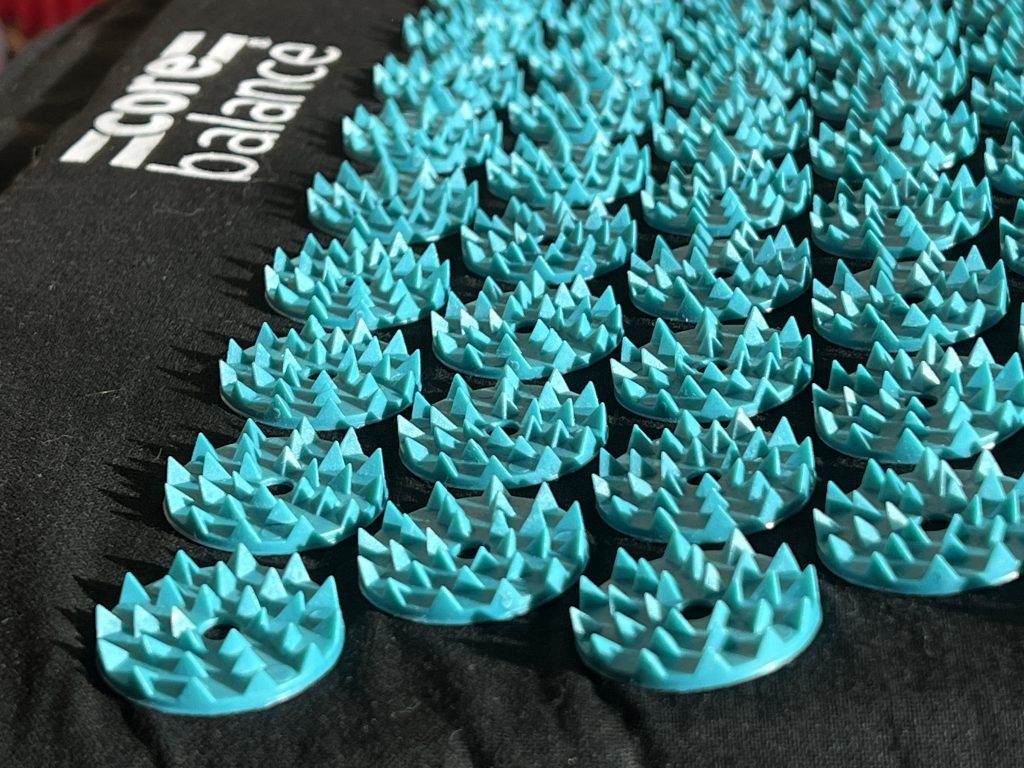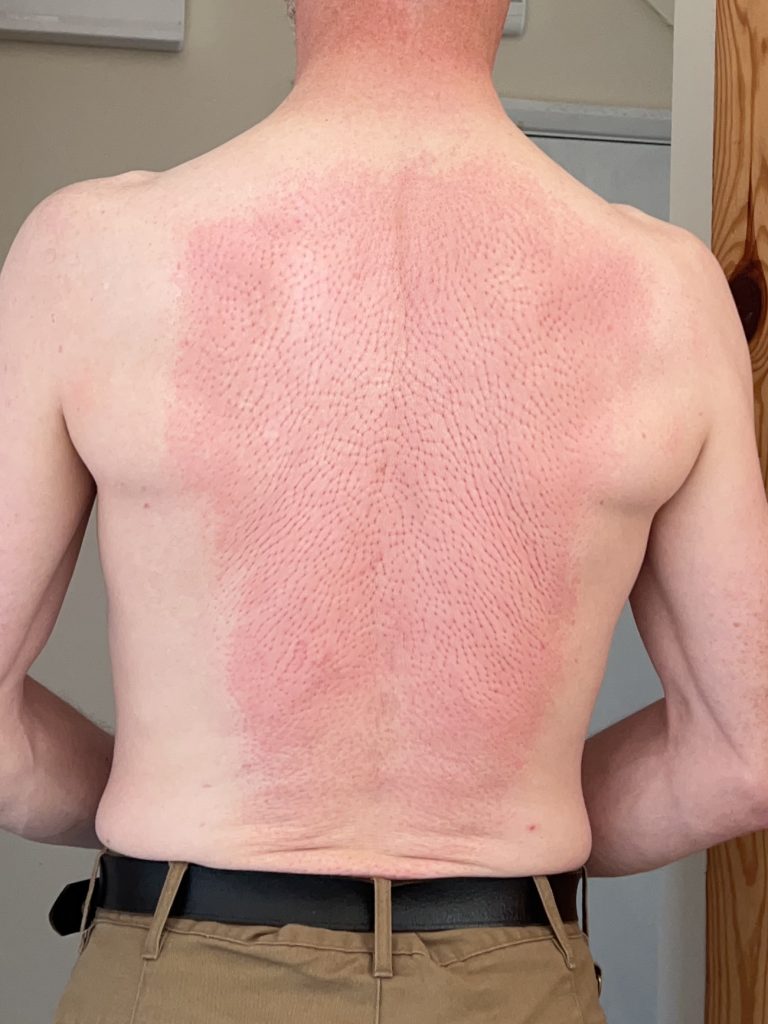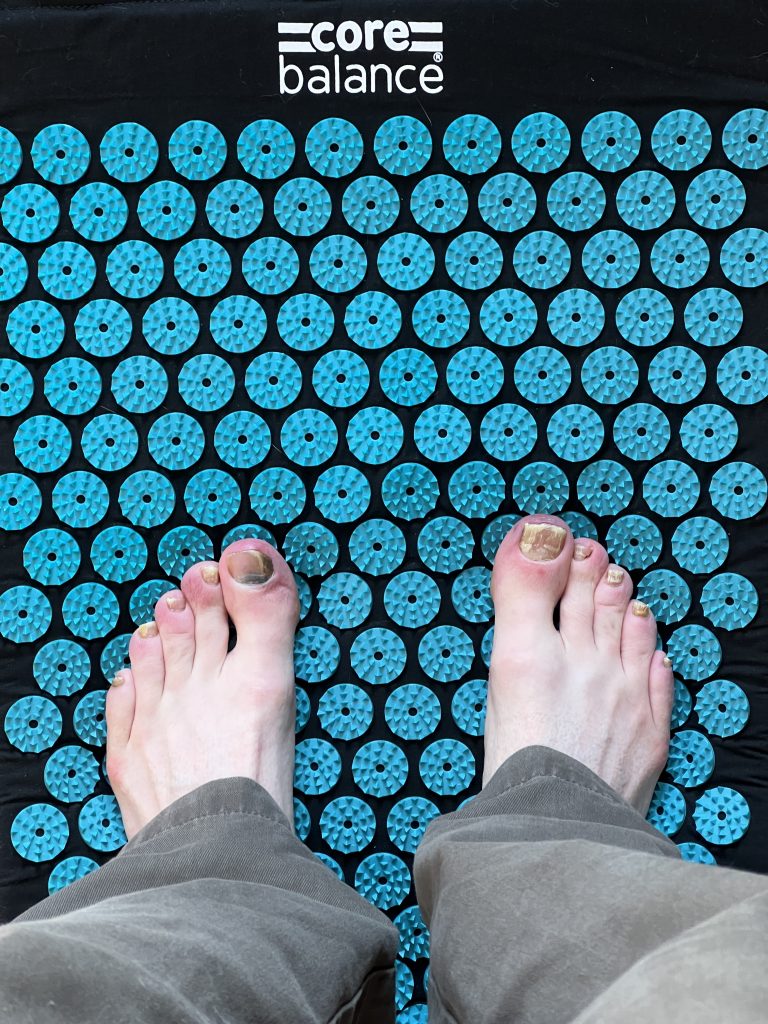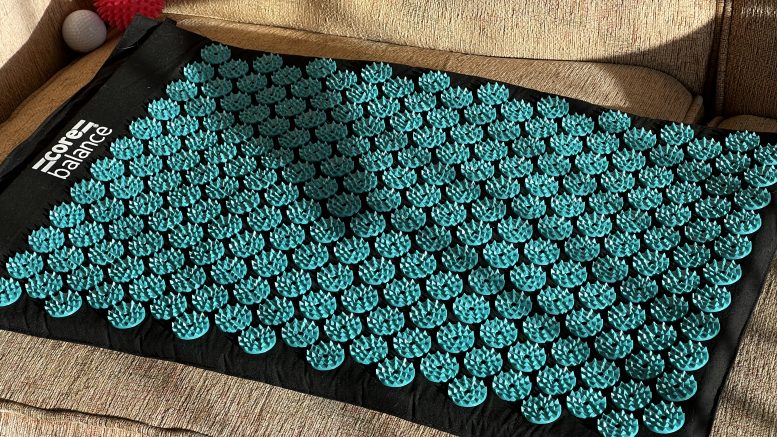Back in January whilst wading through the swamp that is Twitter I came across a thread from several runners I follow about a product I’d never seen before. They were discussing a pictured acupressure mat and whether or not it did anything useful. I can’t remember whether there was a consensus of opinion, but it did result in me opening another browser tab and heading over to Amazon “to do some research”.
Typing ‘acupressure mat’ into Amazon yielded a page full of very similar looking products with prices ranging from £8 up to £80. These mats appeared to be roughly 1ft x 2ft in size and consisted of many plastic circles of spikes across their front.
Acupressure mats – the “theory”
So, you might be wondering what an acupressure mat was, what it does, and how it does it.
Acupressure pads are a type of “therapy” tool that use small plastic or metal spikes to apply pressure to specific acupressure points on the body. These points are believed to correspond with various organs and systems in the body, and by stimulating them, the pads **may** help to relieve tension, pain, and stress.
When the spikes on the acupressure pads are pressed against the skin, they may trigger the release of endorphins, which are natural painkillers and mood enhancers. This can help to reduce feelings of anxiety and promote a sense of calm and relaxation. Additionally, acupressure pads may increase blood flow and circulation to the areas being treated, which can help to reduce inflammation and improve overall health.
According to their devotees, acupressure pads can be used on various parts of the body, including the back, neck, feet, and hands. They are used by people to try to relieve chronic pain, stress, or tension. However, it’s important to note that while acupressure pads may be a helpful tool for relieving tension, they should not be used as a substitute for medical treatment or advice from a healthcare professional.
But is it science?
No, not at all. It really isn’t.
We’re in the murky world of “complimentary medicine” where anecdotal evidence and feelings risk getting mixed in with scientific facts. They are based upon the concept of a bed of nails in ancient Chinese medicine. These pads could therefore be reimagined as a portable bed of nails, but without a trip to B&Q or the risk of copious amounts of un-necessary bleeding.
As a person of a certain age who has spent far too many hours hunched over computers and pianos etc, I have a body that aches on demand (and also when not asked) so anything that might relieve some of these long-term postural muscle-aches is of interest. Although I generally prefer proper medically-based assistance e.g. a trained physio than potential quackery from the internet.
Shopping for spikes
Once in the shopping emporium that is Amazon UK I scrolled up and down the page trying to work out what the £80 mat did differently to the £8 mat, and decided to pull the trigger on this £8 mat. I figured that if it was so amazing then perhaps I could “upgrade” later, but I would err on the side of quackery first rather than waste a larger amount of money!
I’ll add that this isn’t a sponsored post, nobody has asked me to do a review, but as with any of these things that ‘look interesting’ it’s always fun to experiment and to report back. Interestingly, when I was putting an old newspaper on the fire during one of the many cold night’s we’ve had this winter, I noticed one of the columnists had reviewed a £70 mat which, coincidentally, looked rather similar to my £8 mat. Go figure.

Core Balance acupressure mat rolled up in its carry bag
First impressions
My acupressure mat was duly delivered and came rolled up in its own cloth bag. Useful for transporting around and for storing without risk of spiking yourself on the sharp bits. The mat itself is about half an inch thick padded with foam, which seems quite bizarre given there’s spiky things between you and the spongy pad!

Oooh spiky
The instructions explained that one might prefer to wear light clothing whilst using the mat in order to cushion the feeling of being stabbed a lot. And that initially it would feel prickly but over time the sensation would change to being deeply relaxing….!
Lots of ‘impressions’
I didn’t want lots of little holes in my t-shirt and took the “how painful could it be, really?” approach. So I got a cushion for my head and carefully lowered myself onto the spiky surface. And the instructions were actually pretty accurate, slightly prickly to begin with but over time the sensation was actually not an unpleasant one.
The most ouchie bit of the whole exercise was getting on and off the mat as once you’re flat, there’s equal pressure over the whole surface of whichever body part you’re stabbing, but if you sit up then that pressure all gets concentrated on one area, which is less pleasant. I found that by doing something a bit like a glute bridge it was possible to peel myself off the mat enough to be able to move it out of the way so I could get up.
Oh and if you wonder what you look like after lying on the mat for 20 minutes, it’s something like this (apologies, I’m not in the best of shape at the moment following my Rhabdo adventures in February).

Picture of my back after 20 minutes lying on an acupressure mat
I’ve tried standing on the pad as well and the experience is similar – weird, but not unpleasant.

Standing on an acupressure mat. Yes, my toes are mess.
Conclusion
Whether or not these pads do much I’m not sure at this time. My muscles definitely click-out afterwards as if something has been released, but this might be due to lying on the floor and allowing my back to fully relax. That said just lying on my back on the floor for 20 minutes doesn’t seem to result in all the clickyness but then again I tend not to stay on the floor like that for long as it’s not the most comfortable position. And it’s been quite cold when I’ve been doing this!
Will I be upgrading to the “super-deluxe it-costs-£80” model?
Er, no, I won’t. All these mats appear to work in the same way with the same matrix of spikes all over them. The quality of materials **might** be better on the expensive model, but I’d have to wear out 10 of my cheap mat before breaking even (albeit casting 9 unreliable mats into landfill the process). And if they wear out that easily (unlikely) I can’t imagine the expensive ones being 10 times more resilient.
Should you go out and try one?
If you’re curious about this sort of thing then perhaps it might be fun, but I’d be inclined to do what I did and get a cheaper one. But seriously if you’ve got a bad back or other chronic pain then you’re best off getting it checked out by someone qualified in the field first, as they will be more able to advise of the cause and suggest ways to improve your condition.
Some of the other mats on Amazon come with a spiky pillow included but that didn’t appeal to me. And whilst it might stimulate something in the head, I don’t think it would ease tension in the back. But then again, I’m a scientist by training (shocking, but true) rather than a “oooh I feel X therefore it must be true” sort of person. Sorry internet, that’s just who I am!
Hope that was helpful / interesting / passed 5 minutes of your day!


Be the first to comment on "Core Balance Acupressure Mat – product review"